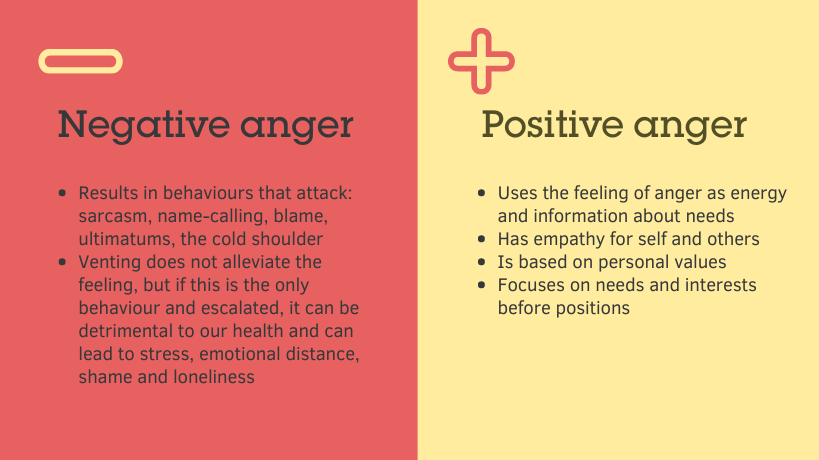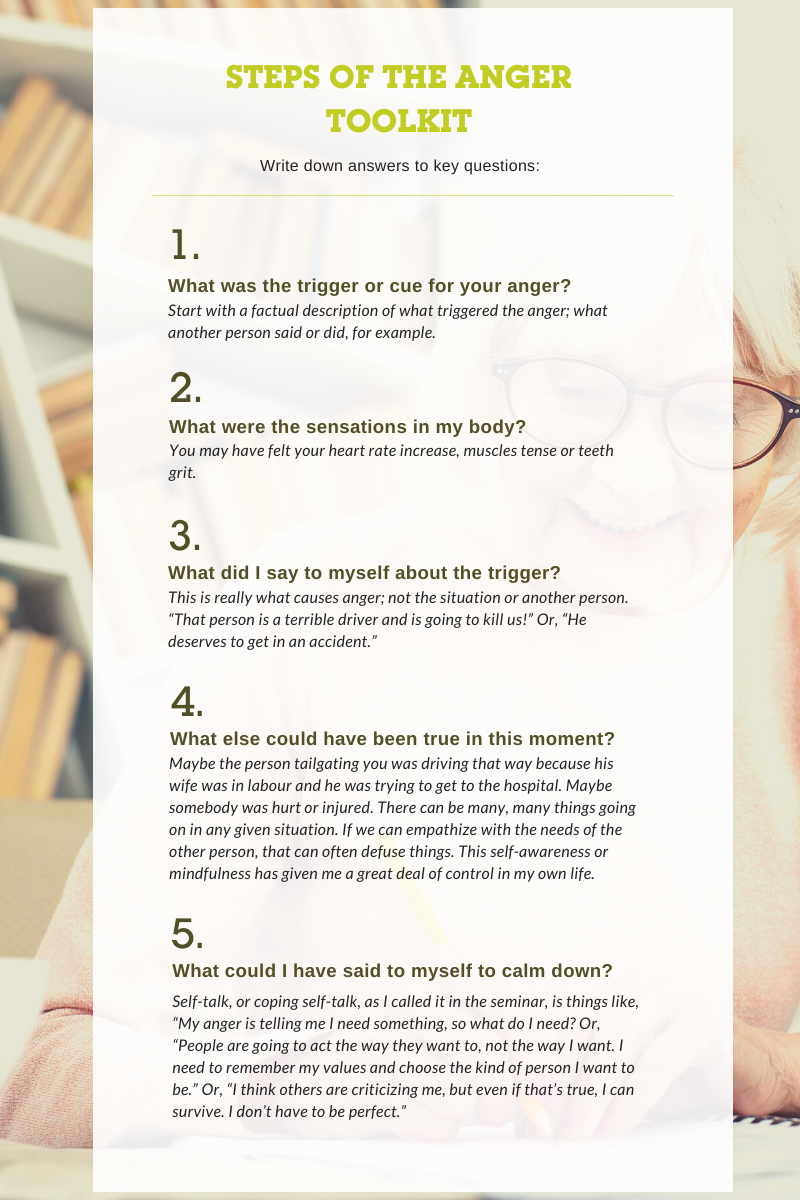Making Friends with Anger
in COVID - 19 NewsWritten by PARC Retirement Living

Anger is a powerful emotion. Out of control, it can get the best of us, causing us to behave in ways that leave us feeling shame and regret. But anger on its own isn’t good or bad – it’s what we do with it that matters. As part of our PARC Retirement Living virtual speaker series, therapist Dale Trimble joined us to give a presentation called “Making Friends with Anger.” For more than 40 years, Dale has been a practising therapist. He provided helpful tools to channel anger in positive and constructive ways, changing how we think about a situation to defuse strong emotions and get our needs met.
Below, he expands on his Anger Toolkit and strategies for coping with anger.

Q&A with Dale Trimble
Q: The title of your presentation is “Making Friends with Anger.” How did you come up with that name?
A: Well, anger is one of the core emotions we all have as human beings, regardless of the culture we’re from. Anger is a healthy response when we perceive our feelings, needs or rights are not being taken into account. However, sometimes it’s a projection from the past triggered by a present issue, but it doesn’t fit the current situation. For example, I’ve come to realize over the years that sometimes if my wife asks me a question, I will think she’s criticizing me when she’s not. I’ve learned to work with that. I’ve “made friends” with the emotion that comes up when I perceive a criticism that really isn’t there. It comes from my own background growing up, and feeling like I’ll never fit in or be good enough. So when I talk about making friends with anger, I mean, recognize the emotion. Anger is always about unmet needs, so this allows you to ask yourself a great question: what is it I’m needing right now? Then you can look to address the need, rather than striking out in some way.
Q: Dr. Gloria McArter mentioned that in her webinar as well. She said it was important to feel and accept all range of emotions, and not sweep difficult emotions like fear, sadness, anger and shame under the rug.
A: Exactly. I think it’s also important to distinguish between the feeling of anger and the behaviour of anger. The behaviour might be clenching muscles, for instance – hands, arms, fists, thighs, legs – accompanied by an increased heart rate. That goes back to our primitive response, which is to flee for safety, or to fight back when we perceive that we can win a conflict. When anger is present, our primitive brain takes over from our pre-frontal cortex, or executive brain. The heart rate and blood pressure rise. Blood flows to the large muscles of the legs and arms to prepare our bodies for fight or flight, and the hormones cortisol and adrenaline flood our brains.
So, the first step in dealing with anger is to tune into all of this and realize that the behavior is different from the feeling. People often confuse the two. When we slow down and say, “What am I feeling? What do I need right now?” – we can make a choice about the behaviour.

Q: I find anger to be one of the most difficult emotions to deal with. It’s hard to stop yourself from reacting negatively when you’re in the middle of it. How do we shift toward a positive outcome?
A: I think we can treat anger as a source of energy and information about our needs. We can have empathy for ourselves for feeling angry and think, “Wow, this is really important for me.” We can try to have empathy for the other person, as in, “What might they be needing?” To reach a place of “positive anger” we need to ask ourselves questions that align with our personal values: “How do I want to express this emotion? Is this best for the kind of person I want to be? How can I be sure I won’t be ashamed, looking back, because I raised my voice or used condescending language or sarcasm?” In other words, the feeling of anger is not the problem. Feelings are always valid. What you choose to do with the feeling is the key, and mindfulness of these things is a powerful tool.
Q: You included some great examples of negative and positive anger in your presentation. Can you share one of those examples?
A: In the seminar, I used an example from the book, Getting to Yes: Negotiating Agreement Without Giving In by William Ury and Roger Fisher. The authors tell a story of a couple who are preparing dinner for guests. The husband is making fancy drinks. He walks in and grabs a lemon out of the refrigerator. His wife says, “I need that lemon.” And he says, “Well, I need that lemon, and you should have gotten more. You should have told me you needed lemons.”
Because the guests are arriving within 10 minutes, one of them decides: “Well, we’ll just cut it in half.” Both are frustrated. At the end of the evening, the husband brings his leftovers from the bar to the kitchen counter, sees her half a lemon there and starts to laugh. She asks, “What are you laughing about?” And he just points to the counter and she starts to laugh, too, because he has only used the lemon zest for his drinks and she only needed the juice. They each could have had a whole lemon! When you start from an uncompromising position like, “I want a whole lemon,” you can get caught up in conflict while overlooking your true need.
Another example I used is: I’m driving, and I look in my rear view mirror and see a big black truck right behind me. I can say to myself, “Who do they think they are? I don’t have to put up with this.” Or, I can slow down and say, “Wow, I’m tensing up. I’m punching the wheel. My belly is tight.” And then: “What am I needing? What am I needing at this moment on the freeway, driving 110 km/h? I need space around me. I need safety.” When I focus on my needs, I can look for a way of meeting those needs, which is, pull onto the shoulder or get in the next lane. Those are the basic steps used in the Anger Toolkit or Anger Diary I work with.
Q: Can you walk us through the steps of the Anger Toolkit in detail?
A: It’s also called an anger diary or journal, and it’s useful when somebody realizes they didn’t like the way they handled their anger in a situation, and they now feel ashamed or embarrassed. Or, they’re still angry about it and they didn’t get the resolution they wanted. It involves exploring – ideally by writing down – the answers to key questions:
Q: Turning this around for a moment, how can we use this knowledge when dealing with someone else who is angry?
A: The best thing you can do in this situation is defuse yourself:
- Know and manage your most common cues and triggers
- Monitor self-talk
- Be aware of your body
- Express your wish to resolve the conflict
- Sit down if possible – this can be calming for each person
- Pay attention to your voice: volume, tone, speed and pitch (researchers say 40% of the message carries through the tone of your voice, and not the message)
You have three main choices when faced with an angry person:
- Stay, manage your stress and defuse your own anger.
- Stay and set limits. Assert yourself (stand up for yourself) without standing on another person.
- Disengage if you are tired or hungry.

Q: You suggest there are two scientifically proven methods of self-soothing. What are they?
A: The first is recognizing one’s breath. But simply by changing our breathing, if we make the exhalation longer than the inhalation, it engages the parasympathetic nervous system, which is about calming and relaxation. The second is awareness of emotion, which regulates the emotion. The prefrontal cortex activity dampens the amygdala firing. It’s a neurological, scientific description of how the awareness of a feeling reduces the intensity of the feeling. This is as opposed to yelling, screaming, or even talking up your anger in your own mind. There’s no self-awareness in that. This reminds me of one of my favorite anger quotes by Carl Jung: “Everything that irritates us about others can lead to an understanding of ourselves.”
This information is not intended as medical advice, and should not replace a one-on-one relationship with a qualified healthcare professional.
For more video lectures on self-improvement and growth, visit PARC’s Virtual Wellness Webinar Series – Pathways Back Toward Calm. Or, visit our independent senior living blog for helpful tips on coping during the COVID-19 pandemic.
- Light Your Pathways – Deborah Braun, M.A., RCC
- Extend the Light – Dr. Gloria McArter, Ph.D., RCC
- Reroute Anxiety – Deborah Braun, M.A., RCC
- Make Friends with Anger – Dale Trimble, M.A., RCC
- Relieve Relationship Distress – Jo-Anne Weiler, M.A., RCC



